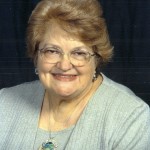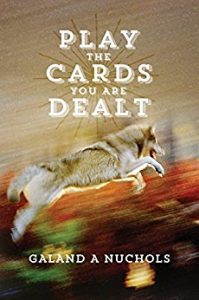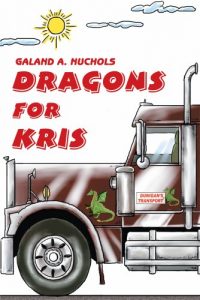Galand Nuchols is a retired school teacher. While teaching, she found that writing short stories that incorporated the names of students helped to improve their interest and motivated them to work harder. At the same time, she found she really liked to write. Once she retired, she dove into writing full time and has turned out a number of books that are not only aimed at young teens, but can actually be a great help to them, particularly boys. This year, she took on another challenge. And today, she tells us about it.
she found that writing short stories that incorporated the names of students helped to improve their interest and motivated them to work harder. At the same time, she found she really liked to write. Once she retired, she dove into writing full time and has turned out a number of books that are not only aimed at young teens, but can actually be a great help to them, particularly boys. This year, she took on another challenge. And today, she tells us about it.
For the least two years I’ve heard about the challenges and difficulties of the NANOWRIMO (National Novel Writing Month) contest. There were a few pros and a lot of cons coming from former participants. So why did it keep tap, tap, tapping at my brain? Why would I even consider giving up an entire month, especially the month of November with all the Thanksgiving and Christmas preparations: decorating, parties, family gatherings, travel, etc. to write 50,000 words in thirty days? For some unexplained reason I chose to do just that, and I learned a lot from the experience.
 Plan ahead is at the top of the to-do list. I knew going in that I had to type an average of 1667 words every day. I realized I would not have the luxury of doing research as the story progressed from scene to scene. I spent hours talking to councilors, nurses, and on the internet collecting information on depression, appendicitis symptoms, the Big Thicket, suicide attitudes, guilt and anything else that I might possibly need, then recording it in a handy file.
Plan ahead is at the top of the to-do list. I knew going in that I had to type an average of 1667 words every day. I realized I would not have the luxury of doing research as the story progressed from scene to scene. I spent hours talking to councilors, nurses, and on the internet collecting information on depression, appendicitis symptoms, the Big Thicket, suicide attitudes, guilt and anything else that I might possibly need, then recording it in a handy file.
Some of my characters were from a previous novel, but I had several new characters and prepared a physical description of each as well as their mental state. That left me time to create a couple of new characters I had not anticipated needing.
There would be several different sites in the novel. I toured the site where my characters would be living and traveling, took pictures of homes, barns, roads, and foliage in the area. A hospital would be needed. Descriptions of the entrance and waiting area of the local hospital were recorded for quick recovery. The highway the characters would be traveling on when they got lost was marked on a map so the proper towns could be named and included. Words counted and I would need all the names and descriptions of people and places I could work in.
A general outline of events that would happen in each chapter was worked out. None of my previous novels had over 25,000 words. I knew I would have to try something different and took a leaf from my favorite author’s writing style. Elizabeth Moon often moves from one character’s point of view to another’s point of view by starting a new chapter. This allows the author to let the reader see more details of the story, and it uses up more words. I decided ahead of time whose point of view and what event would be used in each chapter. This one feature helped me with the ‘head hopping’ errors I made in previous novels, errors my friends noted in their editing of my work.
All this was done before November 1. As it turned out, I still ran out of story before I used up 30,000 words let alone the required 50,000 needed to complete the contest. I had to carry the story of the suicide character on for another twenty thousand words or more. These extra events took time to develop, time I would not have had without the research and recording of information for the first chapters.
When we are faced with a deadline, we often give ourselves a kick in the pants and push on. I found this to be the case when I was tired or undecided on the next paragraph and tempted to stop at 500 words and go to bed or clean house or address Christmas cards. Then the thought of having to type over 2834 words the next day spurred me on to type something, even knowing it would have to be reworded. The idea was to get the story written and polish it later. It didn’t matter that I’d used the word ‘frowned’ fifteen times in the chapter. I pressed on with the idea of using a thesaurus during the cleanup phase after the close of the contest.
When last of those 50,000 words were typed, the story roughed in, and the submit button pushed, the satisfaction of knowing ‘I did it’ was great. The job was done, maybe not well done but done just the same. And best of all, I learned several things in the writing process.
JIM: Thanks, Galand,for enlightening us, and encouraging us. We can all use it. Readers, click here to find more about Galand and her work.

I’ve not participated in NANOWriMo, but I did set up a strict writing schedule for a book I was writing. I discovered what you did: thinking I could make up the words i didn’t write today by writing more the next day was just the kick in the pants I needed to keep me at the keyboard until I completed my day’s quota of words. Yes, 1500 words a say is possible, but stopping short of that so that I had to write over 2000 the next day could have led to being weeks behind if I let it go beyond a day or two. Good for you taking on this challenge.
I applaud anyone who can do NANOWriMo! Personally, I can’t stand the stress! Bravo to Galand for a job well done.
Participating in the NANOWriMo is a tremendous learning experience. I’ve only done it once but reaped the rewards of acquiring new skills in the process. These skills have engaged my writing ever since. And you get such a boost of accomplishment when you achieve such a challenging goal.